What'sNEW Apr - Jun 2018
It was an interstellar comet, not an asteroid that visited our solar system around 9 September 2017,
because its path was apparently altered by venting.
 Mysterious interstellar visitor is a comet - not an asteroid, Nature News, 27 Jun 2018. Mysterious interstellar visitor is a comet - not an asteroid, Nature News, 27 Jun 2018.
 Non-gravitational acceleration ...of 1I/2017 U1 ('Oumuamua) by Marco Micheli et al., Nature, 27 Jun 2018. Non-gravitational acceleration ...of 1I/2017 U1 ('Oumuamua) by Marco Micheli et al., Nature, 27 Jun 2018.
 Thanks,
Centauri Dreams. Thanks,
Centauri Dreams.
 01 Nov 2017: Oumuamua noticed. 01 Nov 2017: Oumuamua noticed.
 Comets... has background. Comets... has background.
|
A series of astronomical observations obtained over the period 1986 to 2018 supports the idea that life is a cosmic rather than a purely terrestrial or planetary phenomenon. These include (1) the detection of biologically relevant molecules in interstellar clouds and in comets, (2) mid-infrared spectra of inter-stellar grains and the dust from comets, (3) a diverse set of data from comets including the Rosetta mission showing consistency with biology and (4) the frequency of Earth-like or habitable planets in the Galaxy. We argue that the conjunction of all the available data suggests the operation of cometary biology and interstellar panspermia rather than the much weaker hypothesis of comets being only the source of the chemical building blocks of life. We conclude with specific predictions on the properties expected of extra-terrestrial life if it is discovered on Enceladus, Europa or beyond. A radically different biochemistry elsewhere can be considered as a falsification of the theory of interstellar panspermia.
— John Lattanzio |
 On Earth 99.999% of organics come from biology. Is it really likely to be 0% in space? — John Lattanzio (pictured), Monash University, Keynote address at the Annual Meeting of the Astronomical Society of Australia, Melbourne, 25 Jun 2018.
On Earth 99.999% of organics come from biology. Is it really likely to be 0% in space? — John Lattanzio (pictured), Monash University, Keynote address at the Annual Meeting of the Astronomical Society of Australia, Melbourne, 25 Jun 2018.
 Astronomical Evidence for Panspermia: video of the address [slide to min. 18:30]. Astronomical Evidence for Panspermia: video of the address [slide to min. 18:30].
 Australian astronomers ponder mounting evidence microbial life may 'hitch-hike' between planets and the stars, multimedia commentary by Jamie Seidel, News Corp Australia Network (+Fox News), 28 Jun 2018. Australian astronomers ponder mounting evidence microbial life may 'hitch-hike' between planets and the stars, multimedia commentary by Jamie Seidel, News Corp Australia Network (+Fox News), 28 Jun 2018.
 Cosmic Biology in Perspective, N. C. Wickramasinghe et al., Astronomical Society of Australia, 22 May 2018, elaborates extensively on the astronomical evidence Lattanzio mentions. Cosmic Biology in Perspective, N. C. Wickramasinghe et al., Astronomical Society of Australia, 22 May 2018, elaborates extensively on the astronomical evidence Lattanzio mentions.
 Introduction... has history. Introduction... has history.
Plumes of ice and water vapor from Enceladus contain complex organics that could come from life. In 2005, NASA's Cassini spacecraft flew through the plumes venting from Enceladus's ice-covered ocean, where it measured particles with two mass-spectrometers. New analysis of the data indicates that the molecules seen were likely fragments of larger, more complex organic molecules. Like in Earth's oceans, organic substances can accumulate efficiently on the bubble walls, thus probing the oceanic organic inventory at depth. Of course, life produces the organics on Earth.
 Macromolecular organic compounds from the depths of Enceladus by Frank Postberg et al., Nature, 27 Jun 2018. Macromolecular organic compounds from the depths of Enceladus by Frank Postberg et al., Nature, 27 Jun 2018.
 Ingredients for Life Found on Saturn's Moon, Enceladus by Charles Q. Choi, ScientificAmerican.com, 27 Jun 2018. Ingredients for Life Found on Saturn's Moon, Enceladus by Charles Q. Choi, ScientificAmerican.com, 27 Jun 2018.
 Saturn moon a step closer to hosting life by Mary Halton, BBC News, 27 Jun 2018. Saturn moon a step closer to hosting life by Mary Halton, BBC News, 27 Jun 2018.
 Thanks, Rob Cooper and Bob Sweeney. Thanks, Rob Cooper and Bob Sweeney.
 Life on Europa, Other Moons, Other Planets? has related links. Also see: Life on Europa, Other Moons, Other Planets? has related links. Also see:
 Ocean in Enceladus Enhances the Case for Panspermia [pdf] by ChandraWickramasinghe et al., SPIE, 28 Sep 2015. Ocean in Enceladus Enhances the Case for Panspermia [pdf] by ChandraWickramasinghe et al., SPIE, 28 Sep 2015.
 Organics Inside Enceladus: Complex Enough for Life? by Elizabeth Howell, Sky & Telescope, 06 Jul 2018. Organics Inside Enceladus: Complex Enough for Life? by Elizabeth Howell, Sky & Telescope, 06 Jul 2018.
 Daring Japanese mission reaches unexplored asteroid Ryugu, Nature News, 26 Jun 2018. Daring Japanese mission reaches unexplored asteroid Ryugu, Nature News, 26 Jun 2018.
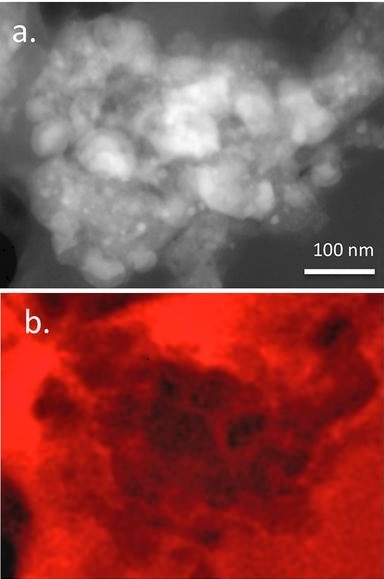 Interplanetary dust particles (IDPs) older than the sun contain complex organics. NASA collected tiny particles in the high atmosphere and confirmed their age by chemical and isotopic analysis. The two studied particles are aggregates of tiny grains of glass with embedded metal and sulfides (GEMSs) in a matrix including the organics. The GEMSs would have formed in high heat, but such heat would destroy organics, so there's a mystery to explain. NASA believes that the grains, after formation, were cycled into a cooler environment such as a comet, where the organic compounds attached to them. Meanwhile, we suggest that the complex organics themselves, surprisingly abundant in space and on comets, are poorly explained without biology.
Interplanetary dust particles (IDPs) older than the sun contain complex organics. NASA collected tiny particles in the high atmosphere and confirmed their age by chemical and isotopic analysis. The two studied particles are aggregates of tiny grains of glass with embedded metal and sulfides (GEMSs) in a matrix including the organics. The GEMSs would have formed in high heat, but such heat would destroy organics, so there's a mystery to explain. NASA believes that the grains, after formation, were cycled into a cooler environment such as a comet, where the organic compounds attached to them. Meanwhile, we suggest that the complex organics themselves, surprisingly abundant in space and on comets, are poorly explained without biology.
Images: a section through a GEMS grain revealing (a) amorphous mineral subgrains and (b) the corresponding carbon element map with organic rims on the subgrains.
 Multiple generations of grain aggregation in different environments preceded solar system body formation by Hope A. Ishii et al., PNAS, 11 Jun 2018. Multiple generations of grain aggregation in different environments preceded solar system body formation by Hope A. Ishii et al., PNAS, 11 Jun 2018.
 Experiments trace interstellar dust back to solar system's formation, University of Hawai'i News, 12 Jun 2018. Experiments trace interstellar dust back to solar system's formation, University of Hawai'i News, 12 Jun 2018.
 NASA captures the primordial dust that formed the planets, Nature, 13 Jun 2018. NASA captures the primordial dust that formed the planets, Nature, 13 Jun 2018.
 Hoyle and Wickramasinghe's Analysis of Interstellar Dust includes a brief introduction to the subject. Hoyle and Wickramasinghe's Analysis of Interstellar Dust includes a brief introduction to the subject.
| 14 Jun 2018 |
What'sNEW about HGT  | | |
A bacterium may acquire a new strand of DNA by reeling it in with an extended nano-scale pilus. Now microbiologists have recorded the process.

 Watch ...Bacteria Harpoon and Swallow DNA to Evolve by Rafi Letzter, LiveScience.com, 12 Jun 2018. Watch ...Bacteria Harpoon and Swallow DNA to Evolve by Rafi Letzter, LiveScience.com, 12 Jun 2018.
 Using Harpoon-Like Appendages, Bacteria 'Fish' for New DNA by Steph Yin, NYTimes.com, 14 Jun 2018. Using Harpoon-Like Appendages, Bacteria 'Fish' for New DNA by Steph Yin, NYTimes.com, 14 Jun 2018.
 Retraction of DNA-bound type IV competence pili initiates DNA uptake during natural transformation in Vibrio cholerae by Courtney K. Ellison et al., Nature Microbiology, 11 Jun 2018. Retraction of DNA-bound type IV competence pili initiates DNA uptake during natural transformation in Vibrio cholerae by Courtney K. Ellison et al., Nature Microbiology, 11 Jun 2018.
 Viruses... describes various methods of HGT. Viruses... describes various methods of HGT.
 Thanks, Google Alerts and Newswise. Thanks, Google Alerts and Newswise.
| 13 Jun 2018 |
What'sNEW about HGT  | | |
Genomicists at the Structural and Genomic Information Laboratory in Marseille observe that the genomes of pandora viruses contain more than a thousand genes. Some of the genes have known functions for the virus itself, but more resemble genes found in other viruses, prokaryotes or eukaryotes. And most, at least two-thirds, are completely unfamiliar "novel" genes (light gray in bargraph). Even the novel ones vary widely among the six pandora strains analysed.
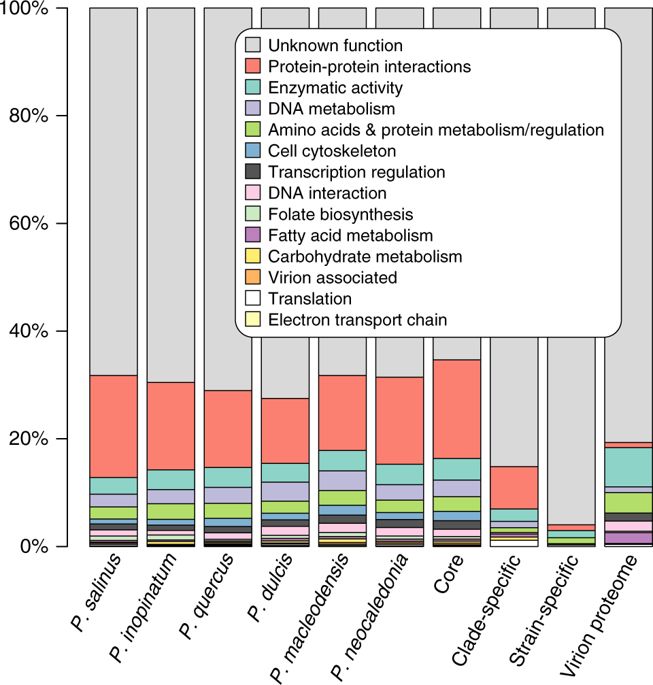
A large fraction of this pan-genome codes for proteins without homologs in cells or other viruses, raising the question of their origin. The analysts acknowledge that random nucleotides are statistically unlikely to ever become functional genes. Besides, the high mutation rate needed to wander in sequence space is not supported by the "strong purifying selection" that the ORFan genes are observed to be under. Nevertheless, the French genomicists conclude, "The pandora genome... offers an ideal playground for de novo gene creation."
Hmm. We admire the diligence that led to discovering these giant viruses from far and wide, and we appreciate the depth and rigor of the new study. But we think the surprising data are better explained if genes simply come first and viruses harbor most of them. Cellular genes in viruses would then make sense, and the unfamiliar novel genes in them would have a purpose — potential future use. Granted, even by cosmic ancestry, evolution would be hit-or-miss. Still, we think it offers the simplest and most elegant solution.
 Diversity and evolution of the emerging Pandoraviridae family by Matthieu Legendre et al., doi:10.1038/s41467-018-04698-4, Nature Communications, 11 Jun 2018. Diversity and evolution of the emerging Pandoraviridae family by Matthieu Legendre et al., doi:10.1038/s41467-018-04698-4, Nature Communications, 11 Jun 2018.
 ...giant viruses invent their own genes, The National Center for Scientific Research (+SciencedDaily), 11 Jun 2018. ...giant viruses invent their own genes, The National Center for Scientific Research (+SciencedDaily), 11 Jun 2018.
 Thanks, Martin Langford and Jerry Chancellor, who asks, "Where is the selection pressure?" Right. Thanks, Martin Langford and Jerry Chancellor, who asks, "Where is the selection pressure?" Right.
 Viruses... is related. Viruses... is related.  Three New Human Genes has become our main webpage about de novo genes. Three New Human Genes has become our main webpage about de novo genes.
Data from the Curiosity rover are consistent with life on Mars. This is the big news that NASA promised for today. But NASA is carefully not saying that the evidence is proof of life. And the astrobiologist writing introductory comments for Science seems unaware that the 1976-77 Viking LR experiments, mentioned here yesterday, got positive results.

 NASA Finds Ancient Organic Material, Mysterious Methane on Mars, news release 18-050, NASA, 07 Jun 2018. NASA Finds Ancient Organic Material, Mysterious Methane on Mars, news release 18-050, NASA, 07 Jun 2018.
 Organic molecules on Mars by Inge Loes ten Kate; re: Organic molecules on Mars by Inge Loes ten Kate; re:
 Organic matter preserved in 3-billion-year-old mudstones at Gale crater, Mars by Jennifer L. Eigenbrode et al.; and: Organic matter preserved in 3-billion-year-old mudstones at Gale crater, Mars by Jennifer L. Eigenbrode et al.; and:
 Background levels of methane in Mars' atmosphere show strong seasonal variations by Christopher R. Webster et al., Science, 08 Jun 2018. Background levels of methane in Mars' atmosphere show strong seasonal variations by Christopher R. Webster et al., Science, 08 Jun 2018.
 Life on Mars? Rover's Latest Discovery Puts It 'On the Table', The New York Times, 07 Jun 2018. Life on Mars? Rover's Latest Discovery Puts It 'On the Table', The New York Times, 07 Jun 2018.
 Thanks for an assist, John Wylie. Thanks for an assist, John Wylie.
 Life on Mars! and Life on Mars! and  A fossil on Mars... are related. A fossil on Mars... are related.
 Gil Levin explains the Viking tests for life on Mars in a 24-min. video posted by ExploreMars, 03 Aug 2014. Gil Levin explains the Viking tests for life on Mars in a 24-min. video posted by ExploreMars, 03 Aug 2014.
 Life on Mars! has background and links. Life on Mars! has background and links.
 Thanks, Bill Smith. Thanks, Bill Smith.
"Through functional, genomic, and evolutionary analysis, we find evidence that with the creation of the modern forms of NOTCH2NL genes in the last few million years after divergence from chimpanzees, humans gained new, secreted NOTCH-like proteins.... Our data suggest that the emergence of NOTCH2NL genes in humans may have contributed to the increase in size and complexity of the human neocortex...." (Fiddes, Lodewijk, et al.)
A multi-disciplinary team has reconstructed the evolutionary history of a gene apparently essential for the development of human brains. Its action in the developing fetus prolongs the growth of the cortex, and defects in the gene correlate with harmful syndromes. Only humans have this gene, but chimps and gorillas have closely related pseudogenes.
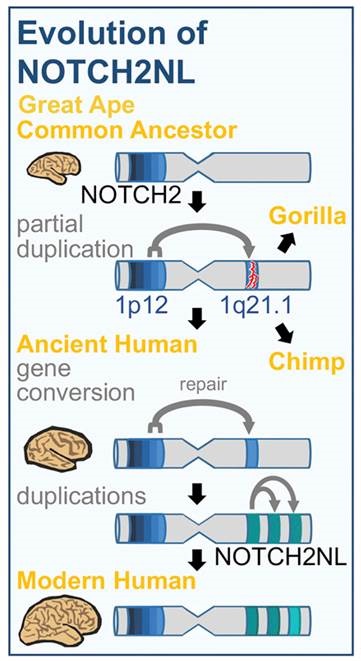
"This suggests a plausible evolutionary history of NOTCH2NL genes as follows: Both the PDE4DIP-NOTCH2NL and MAGI3-NOTCH2NL fusion pseudogenes were present in the LCA of human, chimp, and gorilla. Then, only in the human lineage, the ancestral PDE4DIP-NOTCH2NL fusion gene was 'revived' by NOTCH2 through ectopic gene conversion. With the acquisition of exon 1 and the upstream promoter, a viable NOTCH2NL gene encoding a stable NOTCH2-related protein was created. ...The revived human NOTCH2NL subsequently duplicated twice more to form three nearly identical NOTCH2NL genes.... [W]e estimate that the gene conversion event generating a functional NOTCH2NL happened between 4 and 3 million years ago (mya). This corresponds to a time just before or during the early stages of the expansion of the human neocortex."
A profound evolutionary advance among anthropoids apparently required this intricate process. We do not think standard darwinism explains how this could happen. The production, maintenance and reactivation of pseudogenes, for example, are a complete surprise. The orthodox darwinian speculations from The Economist are especially amusing. But if genomes are able to acquire, assemble, deploy, test and optimise pre-existing programs, as in cosmic ancestry, this and related examples make sense.
 Human-Specific NOTCH2NL Genes Affect Notch Signaling and Cortical Neurogenesis by Ian T. Fiddes, Gerrald A. Lodewijk, et al.; and Human-Specific NOTCH2NL Genes Affect Notch Signaling and Cortical Neurogenesis by Ian T. Fiddes, Gerrald A. Lodewijk, et al.; and
 Human-Specific NOTCH2NL Genes Expand Cortical Neurogenesis through Delta/Notch Regulation by Ikuo K. Suzuki et al., Cell, 31 May 2018. Human-Specific NOTCH2NL Genes Expand Cortical Neurogenesis through Delta/Notch Regulation by Ikuo K. Suzuki et al., Cell, 31 May 2018.
 ...Genes That May Have Influenced Human Brain Size, Howard Hughes Medical Institute (+Newswise), 31 May 2018. ...Genes That May Have Influenced Human Brain Size, Howard Hughes Medical Institute (+Newswise), 31 May 2018.
 A history of big-headedness, The Economist, 31 May 2018. A history of big-headedness, The Economist, 31 May 2018.
 Human Genome Search and Human Genome Search and  New genetic programs... describe a research project to learn the extent to which new human genes depend on horizontal gene transfer (HGT) — including the acquisition of exons and promoters. New genetic programs... describe a research project to learn the extent to which new human genes depend on horizontal gene transfer (HGT) — including the acquisition of exons and promoters.
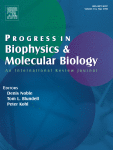 An article by advocates of panspermia is causing a stir. "Cause of Cambrian Explosion - Terrestrial or Cosmic?" with 33 authors, was published online 13 Mar 2018, in Progress in Biophysics and Molecular Biology. The journal offers open access to the paper, but panspermia.org also supplied almost 7,200 downloads in May. Science commentaries, far too many to link from here, are especially noticing the most striking claims in the paper. Some reviews are skeptical or even scornful, but some are balanced. And some of our emails deserve mention:
An article by advocates of panspermia is causing a stir. "Cause of Cambrian Explosion - Terrestrial or Cosmic?" with 33 authors, was published online 13 Mar 2018, in Progress in Biophysics and Molecular Biology. The journal offers open access to the paper, but panspermia.org also supplied almost 7,200 downloads in May. Science commentaries, far too many to link from here, are especially noticing the most striking claims in the paper. Some reviews are skeptical or even scornful, but some are balanced. And some of our emails deserve mention:
 John Lattanzio, Professor of Astrophysics at Monash University, wonders if the word "indisputable" is too strong. Ted Steele and other coathors, including me, respond, 20-21 May 2018. John Lattanzio, Professor of Astrophysics at Monash University, wonders if the word "indisputable" is too strong. Ted Steele and other coathors, including me, respond, 20-21 May 2018.
 Dave Carlson sends compliments and discussion prompted by a topic in the paper, 24 May 2018.
One mostly favorable review comes today from a surprising source, a website that promotes Intelligent Design. The reviewer naturally agrees that darwinism does not adequately account for many aspects of evolution, but complains that panspermia doesn't provide ultimate origins. "They are really just pushing the question backward." That ignores our scientific alternative with no need for origins, but we still enjoyed this review. Dave Carlson sends compliments and discussion prompted by a topic in the paper, 24 May 2018.
One mostly favorable review comes today from a surprising source, a website that promotes Intelligent Design. The reviewer naturally agrees that darwinism does not adequately account for many aspects of evolution, but complains that panspermia doesn't provide ultimate origins. "They are really just pushing the question backward." That ignores our scientific alternative with no need for origins, but we still enjoyed this review.
 ...Scientists Reach (Literally) for the Stars, Evolution News, 25 May 2018. ...Scientists Reach (Literally) for the Stars, Evolution News, 25 May 2018.
 Thanks, Google Alerts. Thanks, Google Alerts.
 metanoia (met-uh-NOI-uh): A profound transformation in one's outlook | A.Word.A.Day, 28 May 2018. metanoia (met-uh-NOI-uh): A profound transformation in one's outlook | A.Word.A.Day, 28 May 2018.
 Cause of Cambrian Explosion - Terrestrial or Cosmic? by Ted Steele, Chandra Wickramasinghe et al., doi:10.1016/j.pbiomolbio.2018.03.004, Progress in Biophysics and Molecular Biology, online 13 Mar 2018. Cause of Cambrian Explosion - Terrestrial or Cosmic? by Ted Steele, Chandra Wickramasinghe et al., doi:10.1016/j.pbiomolbio.2018.03.004, Progress in Biophysics and Molecular Biology, online 13 Mar 2018.
 21 Mar 2018: our first links to and about the subject paper. 21 Mar 2018: our first links to and about the subject paper.
...many genes typically associated with metazoan functions actually pre-date animals themselves.... This casual observation comes in the preface to an extensive computer-driven analysis of metazoan ancestral genes. The thesis of the study, by two British zoologists, is ...the ancestral metazoan genome included a remarkable 1189 Novel HG [homology groups].... The Novel HG comprise 19% of the total HG in the first metazoan....
To them the novel ones imply that the transition was accompanied by an increase of genomic innovation, including many new, divergent, and subsequently ubiquitous genes encoding regulatory functions associated with animal multicellularity. ...There are two alternative scenarios that could explain these patterns.... The first ...would imply an extended 'stew' in which the molecular components of animal biology were assembled. ...The second possibility involves many new genes emerging during a short 'popcorn' stage....
What we find remarkable is that neither the genes that apparently predate animals, nor the novel ones noticed now (quantified by green numbers at every stage in the phylogeny below), have any discernable darwinian provenance. For the novel ones, the "extended stew" has no direct supporting evidence, and the "popcorn stage" has no credible mechanism. None of it makes darwinian sense. But genes that come first, and genes without darwinian provenance are longstanding predictions of cosmic ancestry.
 Reconstruction of the ancestral metazoan genome reveals an increase in genomic novelty by Jordi Paps and Peter W. H. Holland, doi:10.1038/s41467-018-04136-5, Nature Communications, 30 Apr 2018. Reconstruction of the ancestral metazoan genome reveals an increase in genomic novelty by Jordi Paps and Peter W. H. Holland, doi:10.1038/s41467-018-04136-5, Nature Communications, 30 Apr 2018.
 The Very First Animal Appeared Amid an Explosion of DNA by Carl Zimmer, The New York Times, 04 May 2018. The Very First Animal Appeared Amid an Explosion of DNA by Carl Zimmer, The New York Times, 04 May 2018.
 Metazoan Genes Older Than Metazoa? and Metazoan Genes Older Than Metazoa? and  Genes Older Than Earth? discuss genes that come first. Genes Older Than Earth? discuss genes that come first.
 New genetic programs... predicts genes that "seem to have come from nowhere." New genetic programs... predicts genes that "seem to have come from nowhere."
 Three New Human Genes is about de novo genes, the ones with recognizable precursors that were silent, non-functional, aka "junk" sequences. (If that's a provenance, it is not darwinian.) Three New Human Genes is about de novo genes, the ones with recognizable precursors that were silent, non-functional, aka "junk" sequences. (If that's a provenance, it is not darwinian.)
 Thanks, Genevieve Christy. Thanks, Genevieve Christy.
 Update, 10 May 2018: new insight pertaining to
A fossil on Mars resembles one on Earth, posted 28 Oct 2015. Update, 10 May 2018: new insight pertaining to
A fossil on Mars resembles one on Earth, posted 28 Oct 2015. |
 Caenorhabditis elegans Tolerates Hyperaccelerations up to 400,000 x g, de Souza Tiago Alves Jorge and Pereira Tiago Campos, doi:10.1089/ast.2017.1802, Astrobiology, online 10 May 2018. Caenorhabditis elegans Tolerates Hyperaccelerations up to 400,000 x g, de Souza Tiago Alves Jorge and Pereira Tiago Campos, doi:10.1089/ast.2017.1802, Astrobiology, online 10 May 2018.
 Exoplanet Biosignatures: A Review of Remotely Detectable Signs of Life by Edward W. Schwieterman et al., doi:10.1089/ast.2017.1729, Astrobiology, online 04 May 2018. Exoplanet Biosignatures: A Review of Remotely Detectable Signs of Life by Edward W. Schwieterman et al., doi:10.1089/ast.2017.1729, Astrobiology, online 04 May 2018.
| 05 May 2018 |
What'sNEW about HGT  | | |
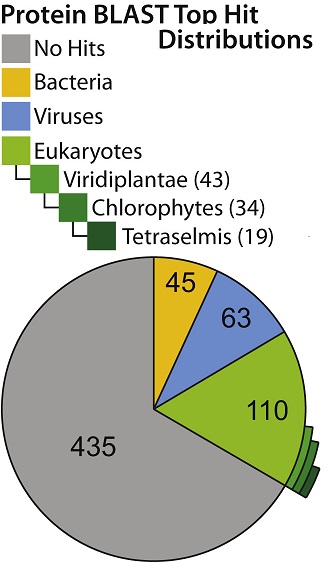 A newly sequenced giant marine virus, TetV, has 663 predicted genes, 435 of which resemble none previously known. More than a hundred encode eukaryotic proteins with close homologs among plants and green algae that the virus infects. Of the rest, 45 are most simlar to to bacterial genes, and 63 to genes found in other viruses (see figure). TetV has a 668-kb dsDNA circular genome.
A newly sequenced giant marine virus, TetV, has 663 predicted genes, 435 of which resemble none previously known. More than a hundred encode eukaryotic proteins with close homologs among plants and green algae that the virus infects. Of the rest, 45 are most simlar to to bacterial genes, and 63 to genes found in other viruses (see figure). TetV has a 668-kb dsDNA circular genome.
What are the eukaryotic and bacterial genes doing there? And where do so many unfamiliar genes keep coming from? What purpose could they serve? And why do the only ten tRNA genes in the genome lie consecutively along one strand of 879 nucleotides?
None of this makes any darwinian sense, but similar evidence is commonplace.
We think alternatives more congruent with the evidence deserve consideration. Of course, horizontal gene transfer (HGT) well explains the close homology between virus and host genes. And cosmic ancestry would give the anomolous genes a reason for being there.
 A giant virus infecting green algae encodes key fermentation genes by Christopher R. Schvarcz and Grieg F. Steward, doi:10.1016/j.virol.2018.03.010, Virology, May 2018. A giant virus infecting green algae encodes key fermentation genes by Christopher R. Schvarcz and Grieg F. Steward, doi:10.1016/j.virol.2018.03.010, Virology, May 2018.
 A new giant virus found in the waters off Oahu, University of Hawaii at Manoa (+ScienceDaily), 03 May 2018. A new giant virus found in the waters off Oahu, University of Hawaii at Manoa (+ScienceDaily), 03 May 2018.
 Viruses... lists many related examples. Viruses... lists many related examples.
 Thanks, Martin Langford. Thanks, Martin Langford.
...this type of organism is of significant interest to the search for past or present life on the Red Planet.
 Microbes Living in a Toxic Volcanic Lake Could Hold Clues to Life on Mars, University of Colorado Boulder via Newswise, 02 May 2018, re: Microbes Living in a Toxic Volcanic Lake Could Hold Clues to Life on Mars, University of Colorado Boulder via Newswise, 02 May 2018, re:
 Lack of Microbial Diversity in an Extreme Mars Analog Setting: Poás Volcano, Costa Rica by Brian M. Hynek et al., doi:10.1089/ast.2017.1719, Astrobiology, online 24 Apr 2018. Lack of Microbial Diversity in an Extreme Mars Analog Setting: Poás Volcano, Costa Rica by Brian M. Hynek et al., doi:10.1089/ast.2017.1719, Astrobiology, online 24 Apr 2018.
 Bacteria... has more about extremophiles. Bacteria... has more about extremophiles.
 Life on Mars! is related. Life on Mars! is related.
| 02 May 2018 |
What'sNEW about HGT  | | |
...Steamer-like elements are present in the genomes of completely unrelated organisms, including zebrafish, sea urchin, acorn worms, and coral. Phylogenetic incongruity, a patchy distribution, and a higher similarity than would be expected by vertical inheritance all provide evidence for multiple long-distance cross-phyla horizontal transfer events. These data suggest that over both short- and long-term evolutionary timescales, Steamer-like retrotransposons, much like retroviruses, can move between organisms and integrate new copies into new host genomes.
 Horizontal transfer of retrotransposons between bivalves and other aquatic species of multiple phyla by Michael J. Metzger et al., doi:10.1073/pnas.1717227115, PNAS, 01 May 2018. Horizontal transfer of retrotransposons between bivalves and other aquatic species of multiple phyla by Michael J. Metzger et al., doi:10.1073/pnas.1717227115, PNAS, 01 May 2018.
|
In cosmic ancestry, horizontal gene transfer (HGT) is essential for evolutionary progress. The importance of HGT among prokaryotes is now well-accepted. Among eukaryotes, the evidence has become hard to dismiss.
 Viruses... has background and What'sNEW links to hundreds of other examples of HGT benefitting eukaryotes. Viruses... has background and What'sNEW links to hundreds of other examples of HGT benefitting eukaryotes.
 Leave Mars to the robots by David Weintraub, LA Times.com, accessed 29 Apr 2018. Leave Mars to the robots by David Weintraub, LA Times.com, accessed 29 Apr 2018.
 Thanks, Bob Sweeney. Thanks, Bob Sweeney.
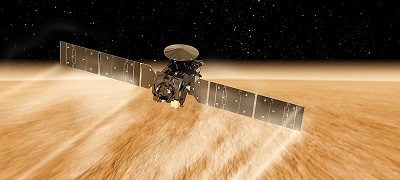 ...it is natural to ask whether methane on Mars is also of biologic origin.
...it is natural to ask whether methane on Mars is also of biologic origin.
 Mars probe poised to solve red planet's methane mystery, Nature News, 23 Apr 2018. Mars probe poised to solve red planet's methane mystery, Nature News, 23 Apr 2018.
The results indicate that methanogens could survive on Mars as it exists today....
 Survival of non-psychrophilic methanogens exposed to martian diurnal and 48-h temperature cycles by R.L.Mickol et al., Planetary and Space Science, online 21 Mar 2018, and commentary: Survival of non-psychrophilic methanogens exposed to martian diurnal and 48-h temperature cycles by R.L.Mickol et al., Planetary and Space Science, online 21 Mar 2018, and commentary:
 ...Some Types of Life Can Survive Conditions Found on Mars, University of Arkansas (+Newswise), 23 Apr 2018. ...Some Types of Life Can Survive Conditions Found on Mars, University of Arkansas (+Newswise), 23 Apr 2018.
 Life on Mars! has more about methane there. Life on Mars! has more about methane there.

 ...a brief history of panspermia and ...a brief history of panspermia and
 ...the return of panspermia | local PDF by Stephen Fleischfresser, Cosmos, 23 and 26 Apr 2018, re: ...the return of panspermia | local PDF by Stephen Fleischfresser, Cosmos, 23 and 26 Apr 2018, re:
 Cause of Cambrian Explosion - Terrestrial or Cosmic? by Ted Steele, Chandra Wickramasinghe et al., doi:10.1016/j.pbiomolbio.2018.03.004, Progress in Biophysics and Molecular Biology, online 13 Mar 2018. Cause of Cambrian Explosion - Terrestrial or Cosmic? by Ted Steele, Chandra Wickramasinghe et al., doi:10.1016/j.pbiomolbio.2018.03.004, Progress in Biophysics and Molecular Biology, online 13 Mar 2018.
What signature would our civilization leave in the fossil record? This seemingly gratuitous question is more consequential than it appears, as we learn in a deep analysis by an astrophysicist and an astrobiologist. Of special interest to us, a long-extinct advanced civilization on one of our neighboring planets might be hard to notice.
 ...in ocean sediment ...the Anthropocene will likely only appear as a section a few cm thick.... ...in ocean sediment ...the Anthropocene will likely only appear as a section a few cm thick....
 Conceivably, deep drilling operations could be carried out on [Venus or Mars in the] future to assess their
geological history. This would constrain consideration of what the fingerprint might be of life, and even organized civilization. Conceivably, deep drilling operations could be carried out on [Venus or Mars in the] future to assess their
geological history. This would constrain consideration of what the fingerprint might be of life, and even organized civilization.
 While we strongly doubt that any previous industrial civilization existed before our own, asking the question in a formal way that articulates explicitly what evidence for such a civilization might look like raises its own useful questions related both to astrobiology and to Anthropocene studies. While we strongly doubt that any previous industrial civilization existed before our own, asking the question in a formal way that articulates explicitly what evidence for such a civilization might look like raises its own useful questions related both to astrobiology and to Anthropocene studies.
 The Silurian Hypothesis: Would it be possible to detect an industrial civilization in the geological record? by Gavin A. Schmidt and Adam Frank, arXiv:1804.03748 [astro-ph.EP], online 10 Apr 2018. The Silurian Hypothesis: Would it be possible to detect an industrial civilization in the geological record? by Gavin A. Schmidt and Adam Frank, arXiv:1804.03748 [astro-ph.EP], online 10 Apr 2018.

 It would be easy, therefore, to miss an industrial civilization that only lasted 100,000 years—which would be 500 times longer than our industrial civilization has made it so far. It would be easy, therefore, to miss an industrial civilization that only lasted 100,000 years—which would be 500 times longer than our industrial civilization has made it so far.
 Was There a Civilization On Earth Before Humans? by Adam Frank, The Atlantic, 13 Apr 2018. Was There a Civilization On Earth Before Humans? by Adam Frank, The Atlantic, 13 Apr 2018.
 Thanks, Nature Briefing, Bob Sweeney, George Nickas and Stumble Upon. Thanks, Nature Briefing, Bob Sweeney, George Nickas and Stumble Upon.
 Civilization Before Homo Sapiens?, commentary by Paul Gilster, Centauri Dreams, 18 Apr 2018. Civilization Before Homo Sapiens?, commentary by Paul Gilster, Centauri Dreams, 18 Apr 2018.
 How Would We Know...?, commentary by Charles Q. Choi, LiveScience, 18 Apr 2018. How Would We Know...?, commentary by Charles Q. Choi, LiveScience, 18 Apr 2018.
 06 Aug 2019: "Humans versus Earth: the quest to define the Anthropocene", Nature News Feature. ...the researchers need to find a representative marker in the rock record that identifies the point at which human activity exploded to such a massive scale that it left an indelible signature on the globe. 06 Aug 2019: "Humans versus Earth: the quest to define the Anthropocene", Nature News Feature. ...the researchers need to find a representative marker in the rock record that identifies the point at which human activity exploded to such a massive scale that it left an indelible signature on the globe.
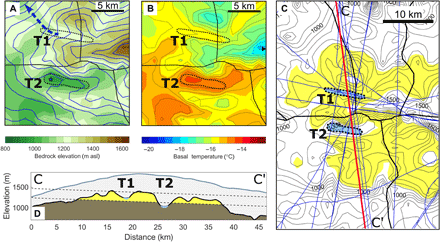 ...these previously unknown hypersaline subglacial lakes ...are compelling analogs for potential ice-covered brine lakes and lenses on planetary bodies....
...these previously unknown hypersaline subglacial lakes ...are compelling analogs for potential ice-covered brine lakes and lenses on planetary bodies....
 Discovery of a hypersaline subglacial lake complex beneath Devon Ice Cap, Canadian Arctic by Anja Rutishauser et al., Science Advances, 11 Apr 2018. Discovery of a hypersaline subglacial lake complex beneath Devon Ice Cap, Canadian Arctic by Anja Rutishauser et al., Science Advances, 11 Apr 2018.
...the lakes may have been sealed off ...for up to 120,000 years.
 Isolated lakes found beneath Canadian ice sheet by Mary Halton, BBC News, 12 Apr 2018. Isolated lakes found beneath Canadian ice sheet by Mary Halton, BBC News, 12 Apr 2018.
 Thanks, Bob Sweeney. Thanks, Bob Sweeney.
 Life on Europa, Other Moons, Other Planets? and Earth-analogs for those environments has related links. Life on Europa, Other Moons, Other Planets? and Earth-analogs for those environments has related links.
 Seeding alien worlds with terrestrial life is now being discussed
Seeding alien worlds with terrestrial life is now being discussed
 Colonising the galaxy is hard. Why not send bacteria instead? The Economist, 12 Apr 2018. Colonising the galaxy is hard. Why not send bacteria instead? The Economist, 12 Apr 2018.
 Panspermia Asks New Questions mentions directed panspermia among other varieties. Panspermia Asks New Questions mentions directed panspermia among other varieties.
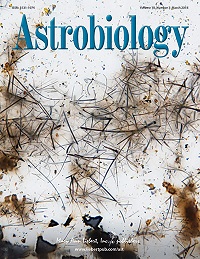 ...another, hitherto unrecognized environment is proposed as a site for the origin of life on Earth.
...another, hitherto unrecognized environment is proposed as a site for the origin of life on Earth.
 A Hydrothermal-Sedimentary Context for the Origin of Life by F. Westall et al., Astrobiology, 01 Mar 2018. A Hydrothermal-Sedimentary Context for the Origin of Life by F. Westall et al., Astrobiology, 01 Mar 2018.
 The RNA World... has background and links about Origin-of-Life theories. These no longer deal with the software problem. Even the hardware problem is sometimes set aside while a conducive environment is suggested, as by Westall et al. The RNA World... has background and links about Origin-of-Life theories. These no longer deal with the software problem. Even the hardware problem is sometimes set aside while a conducive environment is suggested, as by Westall et al.
| 04 Apr 2018 |
What'sNEW about HGT  | | |

 Transposable elements are the primary source of novelty in primate gene regulation by Marco Trizzino et al., Genome Res., online 30 Aug 2017. Transposable elements are the primary source of novelty in primate gene regulation by Marco Trizzino et al., Genome Res., online 30 Aug 2017.
 Human Genome Search and Human Genome Search and  New genetic programs... describe a research project to learn if most new human genes come from horizontal gene transfer (HGT). Since transposons are likely installed by viruses, we think Trizzino et al. support the HGT hypothesis. New genetic programs... describe a research project to learn if most new human genes come from horizontal gene transfer (HGT). Since transposons are likely installed by viruses, we think Trizzino et al. support the HGT hypothesis.
 Viruses and Other Gene Transfer Mechanisms is the main related local webpage. Viruses and Other Gene Transfer Mechanisms is the main related local webpage.
![]()
|
|
 On Earth 99.999% of organics come from biology. Is it really likely to be 0% in space? — John Lattanzio (pictured), Monash University, Keynote address at the Annual Meeting of the Astronomical Society of Australia, Melbourne, 25 Jun 2018.
On Earth 99.999% of organics come from biology. Is it really likely to be 0% in space? — John Lattanzio (pictured), Monash University, Keynote address at the Annual Meeting of the Astronomical Society of Australia, Melbourne, 25 Jun 2018.
 Interplanetary dust particles (IDPs) older than the sun contain complex organics. NASA collected tiny particles in the high atmosphere and confirmed their age by chemical and isotopic analysis. The two studied particles are aggregates of tiny grains of glass with embedded metal and sulfides (GEMSs) in a matrix including the organics. The GEMSs would have formed in high heat, but such heat would destroy organics, so there's a mystery to explain. NASA believes that the grains, after formation, were cycled into a cooler environment such as a comet, where the organic compounds attached to them. Meanwhile, we suggest that the complex organics themselves, surprisingly abundant in space and on comets, are poorly explained without biology.
Interplanetary dust particles (IDPs) older than the sun contain complex organics. NASA collected tiny particles in the high atmosphere and confirmed their age by chemical and isotopic analysis. The two studied particles are aggregates of tiny grains of glass with embedded metal and sulfides (GEMSs) in a matrix including the organics. The GEMSs would have formed in high heat, but such heat would destroy organics, so there's a mystery to explain. NASA believes that the grains, after formation, were cycled into a cooler environment such as a comet, where the organic compounds attached to them. Meanwhile, we suggest that the complex organics themselves, surprisingly abundant in space and on comets, are poorly explained without biology.



 An article by advocates of panspermia is causing a stir. "Cause of Cambrian Explosion - Terrestrial or Cosmic?" with 33 authors, was published online 13 Mar 2018, in Progress in Biophysics and Molecular Biology. The journal offers open access to the paper, but panspermia.org also supplied almost 7,200 downloads in May. Science commentaries, far too many to link from here, are especially noticing the most striking claims in the paper. Some reviews are skeptical or even scornful, but some are balanced. And some of our emails deserve mention:
An article by advocates of panspermia is causing a stir. "Cause of Cambrian Explosion - Terrestrial or Cosmic?" with 33 authors, was published online 13 Mar 2018, in Progress in Biophysics and Molecular Biology. The journal offers open access to the paper, but panspermia.org also supplied almost 7,200 downloads in May. Science commentaries, far too many to link from here, are especially noticing the most striking claims in the paper. Some reviews are skeptical or even scornful, but some are balanced. And some of our emails deserve mention: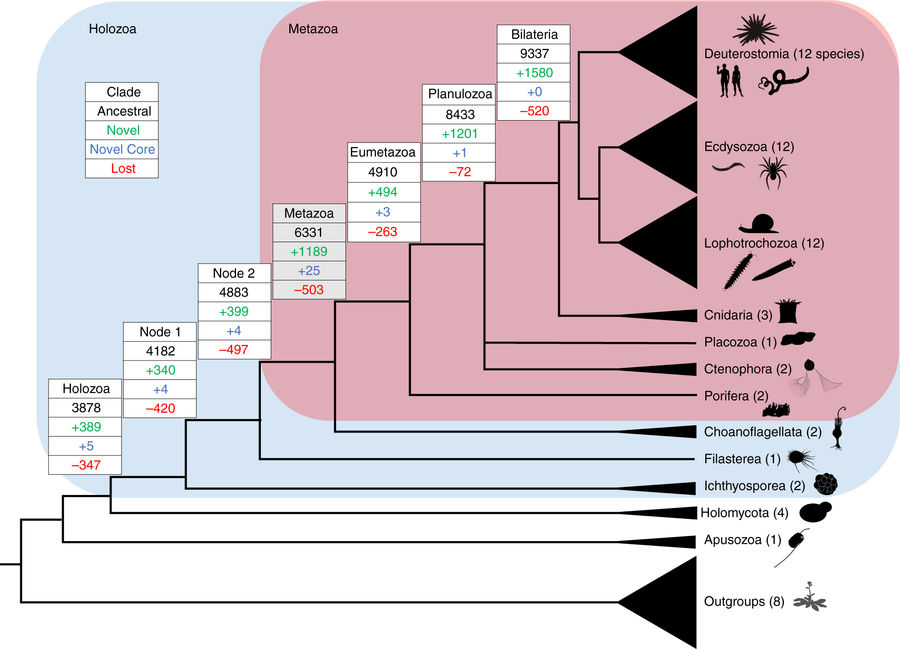
 A newly sequenced giant marine virus, TetV, has 663 predicted genes, 435 of which resemble none previously known. More than a hundred encode eukaryotic proteins with close homologs among plants and green algae that the virus infects. Of the rest, 45 are most simlar to to bacterial genes, and 63 to genes found in other viruses (see figure). TetV has a 668-kb dsDNA circular genome.
A newly sequenced giant marine virus, TetV, has 663 predicted genes, 435 of which resemble none previously known. More than a hundred encode eukaryotic proteins with close homologs among plants and green algae that the virus infects. Of the rest, 45 are most simlar to to bacterial genes, and 63 to genes found in other viruses (see figure). TetV has a 668-kb dsDNA circular genome.


 ...these previously unknown hypersaline subglacial lakes ...are compelling analogs for potential ice-covered brine lakes and lenses on planetary bodies....
...these previously unknown hypersaline subglacial lakes ...are compelling analogs for potential ice-covered brine lakes and lenses on planetary bodies.... Seeding alien worlds with terrestrial life is now being discussed
Seeding alien worlds with terrestrial life is now being discussed

